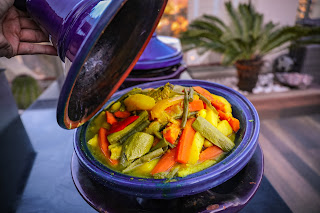What’s a Tajine Anyway?
Tajine – the Cooking Vessel
Tajine – the cooking vessel – is an extremely basic pot that has been utilized for quite a long time. Varieties of the pot are utilized in societies around the globe. The base of the vessel is mud, and the strategies used to make a tajine and other dirt pots have been found as far back as the Neolithic (also called the stone age) time frame. After some time methods and materials were refined however the premise has continued as before. There are two sorts of tajines in Morocco, a coated and unglazed form. You'll additionally discover many hand-painted tajines available to be purchased. These aren't utilized to cook in however can be utilized to serve.
How to Make a Tajine!
One confusion individuals have is that there is a solitary sort of tajine, when in certainty there are handfuls. As much as tajine is a dish, it all the more precisely characterizes a cooking strategy.
There are 4 “must have” components to make a tajine.
The least complex tajine is made with vegetables. The idea of cooking in Morocco is to utilize whatever is in the season so this is the greatest factor in choosing what will be in the tajine. Vegetables are layered from the hardest at the base to the gentlest at the top. They are put in a round example and layered into a cone shape. Flavors are included either as a marinade or dry. Tomatoes are frequently utilized as an extra wellspring of fluid and flavor. A smidgen of water is likewise expected to shield things from consuming and make steam.
When everything is prepared the top is put on and the tajine set over a warmth source. Either charcoal or a low gas fire is the most well-known. A decent cook realizes when to air out the top to check. The food inside prepares by the development of warmth and slight weight so each time the top is expelled the warmth is discharged. This is the reason it's essential to keep it secured as far as might be feasible.
Alongside the cooking, strategy tajines are additionally known for their multifaceted nature of flavor. A blend of sweet and flavorful parts set them apart from different dishes. Probably the most well-known tajines served incorporate chicken tajine with safeguarded lemon and olives, hamburger or sheep tajine with prunes and seared almonds, vegetable tajine with in-season produce, fish tajine with peppers and tomatoes, and meatball tajine with tomato sauce and poached eggs. Occasionally claims to fame like sheep with peas and artichokes or meat with eggplants are an extraordinary treat. In case you're ready to attempt a special tajine either in a home or eatery, do it! Odds are you probably won't discover it again during your visit.
Tajine – the cooking vessel – is a very simple pot that has been used for centuries.
It's run of the mill to see gourmet specialist's and cafés outside Morocco serve tajine with couscous as an afterthought or underneath tajine. This is never done in Morocco. Tajine and couscous are two distinct dinners, prepared various ways and eaten various ways. Try not to expect your tajine to accompany couscous as an afterthought. Rather, you'll use bread to eat the dish. Moroccans use bits of new flatbread to gather up the dish. Eat in the region legitimately before you if offering a dish to other people – the normal method of eating. For the individuals who have a sensitivity to gluten or lean toward not to eat carbs don't be amazed if there are not a single forks to be seen, however don't hesitate to request one.

